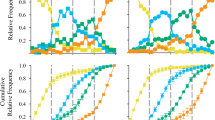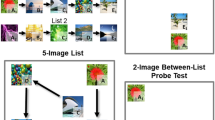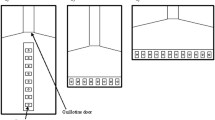Abstract
A hallmark of higher cognition is the flexible use of information. This requires an abstract representation of the information. In sequence learning, ordinal position knowledge is seen as a more versatile representation when compared to chaining. Here, we assessed which of these mental representations is the most natural and most dominant in jackdaws. Two jackdaws (Corvus monedula) were trained on 14 separate three-item sequences (triplets), made up of abstract images. On each trial, the three items of one triplet were presented in fixed order. The images represented either the first, second or third ordinal position. Test stimuli consisted of the three images and a distractor image that was chosen randomly from the remaining sequences. We rewarded pecking in the correct order to the images belonging to the same sequence. The most common error the birds made was to peck at a distractor item from the same ordinal position. To look at how versatile the jackdaws’ ordinal knowledge was, we replaced a familiar item with a novel item in some sequences. We then created novel sequences with these items, which the birds completed correctly. It appears, then, that jackdaws have a concept of ordinal position.





Similar content being viewed by others
References
Biegler R (2006) Functional considerations in animal navigation: how do you use what you know? In: Brown MF, Cook RG (eds) Animal spatial cognition: comparative, neural and computational approaches. [On-line]. Available: www.pigeon.psy.tufts.edu/biegler/
Bonanni R, Natoli E, Cafazzo S, Valsecchi P (2011) Free-ranging dogs assess the quantity of opponents in intergroup conflicts. Anim Cogn 14(1):103–115
Bond AB, Kamil AC, Balda RP (2003) Social complexity and transitive inference in corvids. Anim Behav 65:479–487
Brown MA, Sharp PE (1995) Simulation of spatial learning in the Morris water maze by a neural network model of the hippocampus and nucleus accumbens. Hippocampus 5(3):171–188
Bures J, Buresova O, Nerad L (1992) Can rats solve a simple version of the travelling salesman problem? Behav Brain Res 52:133–142
Cook RG, Brown MF, Riley DA (1985) Flexible memory processing by rats—use of prospective and retrospective information in the radial maze. J Exp Psychol Anim Behav Process 11(3):453–469. doi:10.1037/0097-7403.11.3.453
Cramer AE, Gallistel CR (1997) Vervet monkeys as travelling salesmen. Nature 387:464
Crystal JD (2003) Nonlinearities in sensitivity to time: implications for oscillator-based representations of interval and circadian clocks. In: Meck WH (ed) Functional and neural mechanisms of interval timing. CRC Press, Boca Raton, FL, pp 61–75
Daw ND, Niv Y, Dayan P (2005) Uncertainty-based competition between prefrontal and dorsolateral striatal systems for behavioral control. Nat Neurosci 8(12):1704–1711
Desmond JE, Moore JW (1988) Adaptive timing in neural networks: the conditioned response. Biol Cybern 58:405–415
Fiete IR, Burak Y, Brookings T (2008) What grid cells convey about rat location. J Neurosci 28(27):6858–6871
Honey RC, Hall G (1989) Acquired equivalence and distinctiveness of cues. J Exp Psychol Anim Behav Process 15(4):338–346
Honey RC, Ward-Robinson J (2002) Acquired equivalence and distinctiveness of cues: I. Exploring a neural network approach. J Exp Psychol Anim Behav Process 28(4):378–387
Kaminski J, Call J, Fischer J (2004) Word learning in a domestic dog: evidence for “fast mapping”. Science 304(5677):1682–1683
Lea SEG (1984) In what sense do pigeons learn concepts? In: Roitblat HL, Bever TG, Terrace HS (eds) Animal cognition. Erlbaum, Hillsdale, N.J., pp 263–276
Love BC (2003) Concept learning. In: Nadel L (ed) Encyclopedia of cognitive science, vol 1. Nature Publications, London, pp 646–652
Mackintosh NJ (2000) Abstraction and discrimination. In: Heyes C, Huber L (eds) The evolution of cognition. MIT Press, Cambridge
Muller RU, Stead M, Pach J (1996) The hippocampus as a cognitive graph. J Gen Physiol 107:663–694
Orlov T, Yakovlev V, Hochstein S, Zohary E (2000) Macaque monkeys categorize images by their ordinal number. Nature 404(6773):77–80
Orlov T, Ami DJ, Yakovlev V, Zohary E, Hochstein S (2006) Memory of ordinal number categories in macaque monkeys. J Cogn Neurosci 18(3):399–417
Paz-y-Mino G, Bond AB, Kamil AC, Balda RP (2004) Pinyon jays use transitive inference to predict social dominance. Nature 430(7001):778–781
Pepperberg IM (1994) Evidence for numerical competence in an African Grey parrot (Psittacus erithacus). J Comp Psychol 108(1):36–44
Pepperberg IM (2006a) Grey parrot (Psittacus erithacus) numerical abilities: addition and further experiments on a zero-like concept. J Comp Psychol 120(1):1–11
Pepperberg IM (2006b) Ordinality and inferential ability of a Grey parrot (Psittacus erithacus). J Comp Psychol 120(3):205–216
Pepperberg IM (2006c) Grey parrot numerical competence: a review. Anim Cogn 9:377–391
Railton RCR, Foster TM, Temple W (2010) Transfer of stimulus control from a TFT to CRT screen. Behav Process 85(2):111–115
Ratterman M, Spector L, Grafman J, Levin H, Harward H (2001) Partial and total-order planning: evidence from normal and prefrontally damaged populations. Cogn Sci 25:941–975
Rescorla R (1991) Associative relations in instrumental learning: the eighteenth Bartlett memorial lecture. Q J Exp Psychol 43B:1–23
Reznikova Z, Ryabko B (2011) Numerical competence in animals, with an insight from ants. Behaviour 148(4):405–434
Röell A (1978) Social behaviour of the jackdaw, Corvus monedula, in relation to its niche. Behaviour 64(1–2):1–124
Roitblat HL (1980) Codes and coding processes in pigeon short-term memory. Anim Learn Behav 8(3):341–351
Saleh N, Chittka L (2007) Traplining in bumblebees (Bomus impatiens): a foraging strategy’s ontogeny and the importance os spatial reference memory in short-range foraging. Oecologia 151:719–730
Scarf D, Colombo M (2008) Representation of serial order: a comparative analysis of humans, monkeys and pigeons. Brain Res Bull 76:307–312
Schloegl C (2011) What you see is what you get—reloaded: can jackdaws (corvus monedula) find hidden food through exclusion? J Comp Psychol 125(2):162–174
Schloegl C, Dierks A, Gajdon G K, Huber L, Kotrschal K, Bugnyar T (2009) What you see is what you get? Exclusion performances in ravens and keas. PLoS one 4(8):e6368. doi:10.1371/journal.pone.0006368
Terrace HS (1986) A nonverbal organisms knowledge of ordinal position in a serial-learning task. J Exp Psychol Anim Behav Process 12(3):203–214
Terrace HS (2005) The simultaneous chain: a new approach to serial learning. Trends Cogn Sci 9(4):202–210
Terrace HS, Chen SF, Jaswal V (1996) Recall of three-item sequences by pigeons. Anim Learn Behav 24(2):193–205
Vaughan W (1988) Formation of equivalence sets in pigeons. J Exp Psychol Anim Behav Process 14:36–42
Wilson B, Mackintosh NJ, Boakes RA (1985) Transfer of relational rules in matching and oddity learning by pigeons and corvids. Q J Exp Psychol B Comp Physiol Psychol 37(4):313–332
Young RK (1962) Tests of 3 hypotheses about effective stimulus in serial learning. J Exp Psychol 63(3):307–313
Acknowledgments
We thank S. Healy, T. Bugnyar, L. Kennair and U. Tölch for comments on an earlier draft. We especially thank S. Healy for advice on language and comments on complexity of cognition.
Author information
Authors and Affiliations
Corresponding author
Rights and permissions
About this article
Cite this article
Pfuhl, G., Biegler, R. Ordinality and novel sequence learning in jackdaws. Anim Cogn 15, 833–849 (2012). https://doi.org/10.1007/s10071-012-0509-7
Received:
Revised:
Accepted:
Published:
Issue Date:
DOI: https://doi.org/10.1007/s10071-012-0509-7




